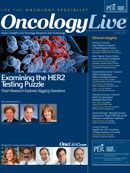Publication
Article
Oncology Live®
Analyzing Disease Flares: Impact of Discontinuing Targeted Therapy Unclear
Author(s):
It is always difficult to distinguish what may legitimately be considered disease flare from the more likely scenario of the events simply representing the natural history of the malignancy.
Maurie Markman, MD
Editor-in-Chief of OncologyLive
Senior vice president for Clinical Affairs and National Director for Medical Oncology Cancer Treatment Centers of America, Eastern Regional Medical Center
The concept that patients with cancer may experience relatively rapid progression of their disease process following the withdrawal of a particular antineoplastic agent is certainly not a new concept.1 Although it is always difficult to distinguish what may legitimately be considered disease flare from the more likely scenario of the events simply representing the natural history of the malignancy, reports of such experiences after the discontinuation of hormonal therapeutic strategies have been well documented. More recently, disconcerting events have been described following the stopping of bevacizumab treatment in patients with malignant brain tumors.2
In the case of targeted antineoplastic drug therapy, a very solid theoretical rationale can be advanced to explain how discontinuation of therapy, either because of excessive toxicity or the documented failure of the regimen to favorably impact the course of the disease, might quite realistically result in far more rapid progression of the malignant process than predicted by observations of the cancer’s natural history in an individual patient.
It has long been appreciated that the secretion of greater local and circulating concentrations of growth factors that can overcome the inhibitory effects of a particular antineoplastic agent is one prominent mechanism of cancer resistance. Assuming that a targeted therapy has been effective in blocking access of an essential growth factor to a clinically relevant target, release of that blockade (following withdrawal of the therapy) may expose these active receptors to a local environment composed of far greater concentrations of the growth stimulatory substances.
As a result, while disease progression may have unequivocally already occurred in a relatively small proportion of the malignant cells, it is theoretically reasonable to propose that the subsequent complete release from receptor blockage (due to discontinuation of the targeted antineoplastic) will result in acceleration of biological activity in a much larger percentage of the malignant cell population.
To address this clinically relevant question in the setting of treatment with tyrosine kinase inhibitors of the epidermal growth factor receptor (EGFR), investigators retrospectively examined the outcome of a group of patients who developed resistance to either gefitinib or erlotinib and were subsequently scheduled to participate in trials exploring novel strategies to overcome such resistance.3 As a component of the study designs, a prospectively defined “washout” period was included in which patients had the tyrosine kinase inhibitor discontinued before the new treatment was initiated. In this experience, disease flare, defined as death or required hospitalization prior to the initiation of the new therapy, was observed in 14 of 61 patients (23%). The median time to this event was only 8 days (range, 3-21 days), with the observed onset of significant symptoms, rapid increases in the extent of cancer, and short survival.
It is theoretically reasonable to propose that the discontinuation of a targeted therapy that blocks a receptor will result in an acceleration of biological activity in a much larger percentage of the malignant cell population.
While this single report cannot be considered definitive with regard either to defining the percentage of patients at risk or to the magnitude of symptomatic progression if disease flare occurs, the experience strongly suggests that lung cancer patients who are receiving EGFR tyrosine kinase inhibitors require careful monitoring if such therapy is discontinued secondary to disease progression, unacceptable toxicity, or patient choice.
Finally, it will be important for the clinical oncology research community to continue to investigate the issue of disease flare in this setting as targeted antineoplastic therapy becomes an integral component of care in an increasing number of clinical settings.
References
- Mortimer JE, Dehdashti F, Siegel BA, et al. Metabolic flare: indicator of hormone responsiveness in advanced breast cancer. J Clin Oncol. 2001;19(11):2797-2803.
- Chi AS, Norden AD, Wen PY. Antiangiogenic strategies for treatment of malignant gliomas. Neurotherapeutics. 2009:6(3):513-526.
- Chaft JE, Oxnard GR, Sima CS, et al. Disease flare after tyrosine kinase inhibitor discontinuation in patients with EGFR-mutant lung cancer and acquired resistance to erlotinib or gefitinib: implications for clinical trial design. Clin Cancer Res. 2011;17(10):6298-6303.





























%20(2)%201-Recovered-Recovered-Recovered-Recovered-Recovered-Recovered-Recovered-Recovered-Recovered-Recovered-Recovered-Recovered-Recovered-Recovered-Recovered-Recovered-Recovered.jpg?fit=crop&auto=format)
%20(2)%201-Recovered-Recovered-Recovered-Recovered-Recovered-Recovered-Recovered-Recovered-Recovered-Recovered-Recovered-Recovered-Recovered-Recovered-Recovered-Recovered-Recovered.jpg?fit=crop&auto=format)
